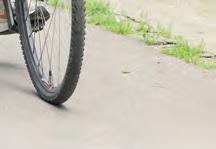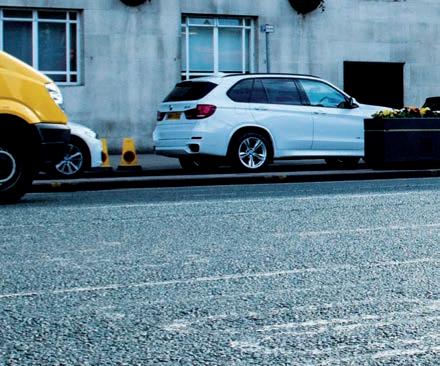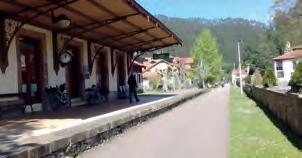













































LAID-BACK CYCLING ICE Adventure recumbent trike



































































LAID-BACK CYCLING ICE Adventure recumbent trike




















Vicky Balfour’s ‘Adventures for all’ article is my favourite in this issue. For one thing it’s refreshing – and instructive – to look at a subject like bikepacking through an entirely different lens. The challenge of bikepacking isn’t necessarily big mileages or sleeping in a ditch or self-inflicted deprivation. It can, for family cyclists (I know) and disabled cyclists (I imagine), simply be starting the ride at all.
The article also brought back fond memories. Vicky and her group rode up the Cinder Track from Scarborough to Whitby. I did the same decades ago with my own children. It was traffic free. Distance didn’t matter. Sometimes we just went to YHA Boggle Hole: 13 miles each way, ridden over two days.
Living right next to the Cinder Track made it a much easier adventure for us. (Once when we were family camping, I forgot the tin opener so rode home and got it.) It was easier because, looking back, the hardest thing about family touring in general was getting the bikes to the start of any trip away from home.
If I were doing family tours again now, I’d hire a vehicle. Back then we went by train. It wasn’t easy. I remember running down a platform at Birmingham New Street, pushing a childback triplet with a trailer cycle attached with one hand and a solo bike with a luggage trailer attached with the other – while my wife ushered children aboard. Today that train trip with those bikes is impossible.
The fight for better transport choices – part of Cycling UK’s ‘Freedom to move’ manifesto (p50) – goes on!




34 Roman riding
Coast to coast on Hadrian’s Cycleway
40 Adventures for all
How to make bikepacking family and disability friendly
50 Freedom to move
Our cycling manifesto for the new government
54 Toddling up the Loire
Family touring in the heart of France
20 Shop Window
A cross-section of new products
22 Gear up
Components, accessories and books
62 ICE Adventure 20 Rigid
A recumbent trike for touring and general riding
65 Cube Nuroad Hybrid C:62
SLX 400X
New e-gravel bike with a lightweight mid-motor
69 All-round MTB tyres
DAN JOYCE Editor
Tyres for all-terrain exploring rather than trail centres
04 Freewheeling
Bits and pieces from the bike world
07 This is Cycling UK



Why your vote counts at the upcoming AGM; Cycling UK’s strategy launch in London; supporting our work with a gift in your will; Cycling UK’s big summer raffle; and more
18 You are Cycling UK




On
American Cycling UK member Rob Thurston
31 Letters
Your feedback on Cycle and cycling
47 Weekender
The Wolf Cub bikepacking route in Suffolk
58 Cyclopedia
Questions answered, topics explained
73 Travellers’ Tales
Cycling UK members’ ride reports Top
UK: Parklands, Railton Road, Guildford, GU2 9JX E: cycling@cyclinguk.org W: cyclinguk.org T: 01483 238300. Cycle promotes the work of Cycling UK. Cycle’s circulation is approx. 51,000. Cycling UK is one of the UK’s largest cycling membership organisations, with approx. 70,500 members and affiliates. President: Jon Snow Chief executive: Sarah Mitchell. Cyclists’ Touring Club, a Company Limited by Guarantee, registered in England No 25185, registered as a charity in England and Wales Charity No 1147607 and in Scotland No SC042541. Registered office: Parklands, Railton Road, Guildford, GU2 9JX. CYCLE MAGAZINE: Editor: Dan Joyce E: editor@cyclinguk.org Designer: Christina Richmond Advertising: Jacob Tregear T: 0203 859 7100 E: jacob.tregear@jamespembrokemedia.co.uk Publisher: James Houston. Cycle is published six times per year on behalf of Cycling UK by James Pembroke Media, 90 Walcot Street, Bath, BA1 5BG. T: 01225 337777. Cycle is copyright Cycling UK, James Pembroke Media, and individual contributors. Reproduction in whole or in part without permission from Cycling UK and James Pembroke Media is forbidden. Views expressed in the magazine are those of the individual contributors and do not necessarily reflect those of the editor or the policies of Cycling UK. Advertising bookings are subject to availability, the terms and conditions of James Pembroke Media, and final approval by Cycling UK. Printed by: Acorn Web Offset Ltd, Loscoe Close, Normanton Industrial Estate, Normanton, WF6 1TW T: 01924 220633


Hadrian’s Cycleway partly follows the ancient wall’s path across northern England. Laura Laker and her friend Claire followed it for a three-day tour


We spent the day chasing a dark grey raincloud. My friend Claire, often ahead of me on the hills and behind me on the flats, merrily pedalled along in her pink cycling jacket, which popped pleasingly against the implausibly dark line hovering in the sky, always just ahead of us.
The weather did little to puncture our mood, however, because we were enjoying the second of a nearly perfect three days of cycling. Coastal paths met billiard-smooth tarmac with barely a car in sight, and the scenery stretched before and beside us, first on remarkably flat land and secondly on remarkably hilly.
We were roughly tracing, at least for the central part of the ride, the route of Hadrian’s Wall, an engineering marvel of the Roman era. But for now the road ran, with barely an incline, alongside the coastline on off-road paths and quiet roads. That first day the drizzle set in shortly after leaving our train at Whitehaven.
We’d planned our trip weeks ahead, Claire taking a couple of days away from her infant son and partner, so a little thing like three days of predicted rain wasn’t about to stop us. We arrived at our B&B in Silloth early evening, soaked but happy, and our hosts delighted us with conversation and delicious home-made food, before we dangled all our clothes over a heater and I tried in vain to sleep in the




Laura is a cycling journalist. Her first book, Potholes and Pavements, a Bumpy Ride on Britain’s National Cycle Network, is out now
resulting sauna. Claire had no problem nodding off, I’m pleased to report.
The next morning an equally top-notch breakfast, including home-made bread, set us up for day two. As we stepped outside, a dramatic squall saw Claire and I run for different shelters. Once the rain ceased pummelling the dripping trees of the town’s waterfront park, it revealed the most remarkable view. Standing before the Solway Firth, with Scotland beyond encased in a grey-blue damp, was one single windswept pine, defiant against the elements. The hills of Dumfries and Galloway were distantly lit across the deep blue water in spotlights of golden sun.
We hid under a few more trees during the few moments when we outpaced that cloud that morning, stopping for a snack and a photo somewhere along the road to Carlisle. I was wrongly convinced if I closed my mouth and grinned, you couldn’t see my cheeks were hamster-full with flapjack. We almost died laughing examining the pictures that evening.
We were a bit damp, and Claire had some waterproof socks I was admiring. Struggling to get my bike into the big chainring since its last service, we stopped at Bikeseven cycle shop in Carlisle, hoping for a fix. This turned out to be a very good decision, as they also gave Claire a shorter secondhand handlebar stem at a very good price – her upper body was looking awkwardly stretched out on the bike. The mechanic waved a magic wand over my bike as well; I’d just needed to push harder on the lever, it turned out.

Staff also let us order a delicious local




Vicky is a cycling adventurer, advocate and professional bike mechanic. Her website is vickybikes.co.uk
Over the last few years there has been an explosion of multi-day cycling routes – not least from Cycling UK. Often a mix of road, traffic-free and off-road cycling, they are making adventure cost effective and accessible for so many able-bodied adults. If you’ve got younger children or have a disability, however, it’s easy to feel unseen by route planners.
When Cycling UK launched the Rebellion Way, I was thrilled to hear that a handcyclist on a recumbent trike was one of the inaugural riders. Finally, I felt that there might be a chance for my daughter CeCe and I to join the multi-day ride party. As a mum/support worker for a young person with disabilities, it’s easy to feel left behind when other friends hop on their bikes and pedal off to explore. That one throwaway comment – that the Rebellion Way had been designed to be more accessible – lit up in my brain like a neon sign. I immediately contacted a couple of friends who are also mums, and asked if they’d like to try three days of cycling with us in Norfolk. They agreed.
On closer inspection, even the Rebellion Way’s shorter loop was still going to take about a week for us to complete towing our youngsters. We’d also miss all the beach bits with that shorter version. We weren’t deterred!
Kelly-Jayne (Kell) Collinge and Phoebe Sneddon are my go-to mum adventurers. We were determined to find a way to ride at least part of the Rebellion Way. Phoebe started playing with options on Komoot, and soon we had a ‘taster loop’ that was approximately 30km each day. At this point we had no idea how realistic that was going to be.
Phoebe’s son Torben was only seven months old, Kell’s son Atlas was two and my daughter CeCe was about to turn 17. We were towing all three on trailers: Torben and Atlas in Thule and Burley models, CeCe on her Mission Cycles Piggyback trailer trike. None of us had electric assistance on our bikes. It was deep winter, with piercing sunshine, heavy frost at night and short days. Within a few hours of starting our first day we realised that we’d have to make significant changes to our route to stand any chance of progressing.
“It’s OK, we can cut out Hunstanton today and just go straight to Heacham Manor,” Phoebe said. Prioritising warmth and comfort, we chopped off sections of route with alacrity. The secret to inclusive bikepacking is to keep expectations loose and remember that just being out together is what counts.

Kell and CeCe keeping their spirits up with a mid-ride hug


The following day we again found ourselves racing against the fading light when we pedalled through Holkham Park. As twilight replaced cold winter sun, we had our third puncture


of the day. CeCe began to panic that we wouldn’t make it to our accommodation.
Between soothing her anxiety and fixing the puncture, we pulled together as a unit, seamlessly taking responsibility for different jobs. Before long we were pedalling along the lane to Wells-next-theSea. At that moment a barn owl swooped from the trees and along the hedgerow, starting her evening’s hunt. We pinched ourselves at how lucky we were to witness this moment.
I wrote an article about our adventure towing our children along the Rebellion Way (cyclinguk.org/rebellion-waywith-children). It was also made into a film, ‘Along for the Ride’ ( bit.ly/cyclealongfortheride). Eighteen months on from that, we’ve just launched our second film, ‘Kids & Coastlines’ ( bit.ly/cycle-kids-andcoastlines), which is about bikepacking part of the Route YC cycle route in North Yorkshire. (The route website is at routeyc. co.uk/cycling and GPX files of all the route options can be downloaded from bit.ly/ routeYC-routes-komoot.)
So what have we learned from making these films and from all our other riding?






































AHEAD OF THE GENERAL ELECTION IN JULY, CYCLING UK LAUNCHED ITS OWN MANIFESTO AND CALLED ON ALL CANDIDATES TO SUPPORT IT. DUNCAN DOLLIMORE REPORTS
Following the general election of 4 July, the Labour Party has now formed the UK government. Our asks for this new government are set out in Cycling UK’s ‘Freedom to move’ manifesto for cycling, which was written (like the first draft of this article) before the election took place.
We campaigned furiously to persuade candidates to stand up for cycling if elected. By the time you’re reading this, we’ll have MPs from various parties elected across the UK who’ve pledged to support those asks over the next five years. But before outlining what they were, I’ll start with why they matter.

DUNCAN DOLLIMORE Cycling UK head of campaigns
It feels like longer, but only a couple of years ago there was a broad consensus among political parties in Westminster around the need to invest in active travel to get more people walking and cycling. It wasn’t perfect. There was increased investment in active travel in England but it was well short of the amount needed. There were positive changes to the




Highway Code but without a long-term, well-funded awareness campaign to communicate those changes.
Then that consensus collapsed. Cycling was portrayed as a divisive issue amid toxic arguments about speed limits, low traffic neighbourhoods, emission zones and the behaviour of cyclists.
Some of the responses I received from parliamentary candidates during this election brought it home to me just how much work is needed to reset the narrative. These have included emails about cyclists “becoming even more obnoxious in their attitude”, having “an inflated sense of their own virtue” and “an unrealistic sense of what a motorist can see on a rainy night”, followed by calls for cyclists to be registered, taxed and insured, because the “ignorance” of cyclists is not “complemented by any humility”. And these were people wanting your vote!
Changing the public perception of cycling is one of the main objectives within






Cycling UK’s new five-year strategy (cyclinguk.org/strategy). We won’t change that overnight through a general election campaign alone, but that campaign is part of our wider strategy, so our manifesto and our communication with candidates has focused on a positive vision of what we want to see.
We want bustling high streets you can walk down while breathing clean air. Millions more children walking and cycling to school, because they and their parents feel it’s a safe option. A healthier nation, with more people building physical movement into their daily lives.
That’s the vision we took to the candidates, because it’s one we won’t realise unless the new government enables more people to walk, wheel and cycle. It’s one of the cheapest and most effective health interventions a government can make. And there’s clear evidence that if walking and cycling look and feel like a natural choice for short journeys, millions more people will do so regularly.
Thousands of you emailed your
candidates asking them to support our manifesto, and hundreds of them pledged to do so or asked to meet with us if elected.
As always, your support has been and remains vital, wherever you live in the UK.
For although many transport decisions for Wales, Scotland and Northern Ireland are devolved, our manifesto asks have been developed to resonate in all four nations as policies and commitments both we and our supporters would like to see delivered across the UK, even if the power to make that happen sits outside Westminster.
The culture wars around cycling aren’t limited by nation either, so it’s vital we convey the positive vision of what we want to see to politicians throughout the UK. That’s why we asked every candidate to support measures and policies to:
• Deliver long-term investment in cycling, walking and wheeling
Increase investment in active travel, ramping up to at least 10% of the total transport budget within five years. Local authorities need the security of long-term
funding to have confidence to develop and deliver long-term plans for active travel networks. This isn’t just a transport investment but an investment in public health, people, places, the environment and the future we want for our children.
• Provide better transport choices to reduce traffic
Produce an integrated transport strategy designed to give people more transport choices, with targets to reduce traffic. Some people will have to or still want to drive, but the government must do more to make it easy and enjoyable for the majority to get around by walking, wheeling or cycling, and for public and shared transport to be more accessible. By providing better transport choices, the government can make our day-to-day journeys good for our health, our communities, our economy and our environment, and reduce traffic in line with net zero targets.
• Build truly sustainable new homes and developments
Improve and invest in the planning system so that all new homes and other
Which bike should I buy? Ask us at cyclinguk.org/bikefinder
• For: Sarah McClelland, aged 47, from Stockport • Bike needs: I want to be able to keep cycling – commuting and touring. I find the position on flat-bar hybrids uncomfortable. After my six-mile commute my neck really hurts. • Must have: Front suspension. Comfy seat. 27 gears – I have never been defeated by a hill! • Must not have: Rim brakes. I cycle every day and over winter they wear away so fast. • Budget: £1,500




First off, I think there’s something well worth considering before buying a new bike – as I don’t feel any bike, even with a rigid fork, should leave you suffering discomfort after riding just six miles. A professional bike fit might well pick up on any potential physical issues contributing to your discomfort and should help you set up your present bike better – or ensure any new bike is the perfect fit. It should also help you choose your ideal saddle shape and size.
As for new bikes, there are a couple of flat-bar machines from well-respected manufacturers that fulfil your criteria, with 10-speed cassettes and triple chainsets offering you 30 gear ratios. They both have Suntour suspension forks with 63mm travel and a lockout switch.
The Scott Sub Cross 10 (£1,049, scott-sports.com/gb/en) is available in both men’s and women’s models and comes with wide-ranging Shimano Deore and XT gearing, with a hillfriendly 26/32 bottom gear, Shimano’s excellent hydraulic disc braking and 45mm Kenda tyres. It weighs 12.7kg and has a maximum system weight of 128kg.
The Cube Nature Pro (£899, cube.eu/uk-en) is available with either a dropped – AKA ‘trapeze’ – or near horizontal top tube, and is also based around Deore and XT gearing, with an even lower 26/34 bottom gear and Shimano hydraulic discs. It has a maximum rider and bike weight of 115kg and is a little heavier than the Scott at 14.1kg, though you could trim some of that for road use by going for narrower tyres than its 50mm Schwalbes.
SCOTT SUB CROSS 10
£1,049








It sounds like you’ve been riding hybrids with flat bars that are too low, too far for you to reach comfortably, or both. That will stretch you out and make you crane your neck, as well as forcing you to lean too much of your weight onto the handlebar. It might also mean your arms are locked out, so any vibration from the front wheel will come straight up your arms, exacerbating any shoulder and neck pain. I think you need to sit more upright.
The Cube Touring EXC (£1,099, cube.eu/uk-en) ticks all your boxes. It also comes with Cube’s Comfort Pro adjustable stem, which will enable you to set the handlebar higher and closer. That should alleviate your neck issues. But it is heavy at 16.9kg, due to its suspension fork and extensive equipment. In subsequent correspondence you requested something lighter.
So my recommendation is the Spa Cycles Elan 725 Mk1 Flat Bar Sora 9-speed Triple (currently £1,210, spacycles.co.uk), which weighs less than 11kg. Its taller head tube should sit you up better than the hybrids you’ve owned; I’ve included a photo of just the frameset to show this as clearly as possible.
You can specify the bike with BBB Butterfly Trekking Bars and 40mm Schwalbe Marathon Supremes (in stock at Spa Cycles) for extra comfort, and with the chainring sizes of your choice for easier climbing. The Elan doesn’t come with a suspension fork but a suspension stem such as the Redshift ShockStop (£199.99) should be sufficient for the riding you describe. I think you’d want the shortest, 80mm length.


£1,210

SPA CYCLES ELAN 725 MK1 FLAT BAR









Sitting back and relaxing doesn’t come easily to Dan Joyce, but the ICE Adventure is a recumbent touring trike designed for exactly that

HP VELOTECHNIK
SCORPION
FX
£4,700+
German 20in-wheel folding recumbent trike with rear suspension and, like the ICE Adventure, a huge range of options. Brexit has bumped the price for shipping. hpvelotechnik.com/en

HASE KETTWIESEL
ALLROUND LINEAR
£3,939+
Delta-format trike with a higher seat, 1×11 drivetrain, Avid BB7 brakes, mudguards and lighting. Also German, also with a huge range of options. hasebikes.com/en
ICE has been building recumbent trikes for 26 years and now offers six models, ranging from the VTX fast road machine to the Full Fat off-roader. The Adventure is a tourer.
There’s a huge menu of build options, which you can get a sense of by comparing this test trike with CeCe Balfour’s ICE Adventure (p43). I specified an entry-level build with a rigid frame, 20-inch (ISO 406) wheels all round, big tyres and practical extras like mudguards and a rear rack.
Like all ICE trikes, the Adventure has a ‘tadpole’ format with two wheels at the front. An underseat handlebar and track rods provide intuitive, indirect steering. This is unaffected by braking. The cruciform main frame is chrome-moly steel, while the rear section is aluminium. The latter has an angled hinge so that, with the seat removed, the rear end can be lifted up and over, leaving the rear wheel lying flat(ish) between the front pair. ICE calls this its Compact Flat Twist fold. The folded trike is still too big for a train but will fit in a decent-sized car boot – with the boom between the car seats if space is tight.
There’s just one size of frame, which should fit riders from around 5ft to 6ft 6in as the boom length is highly adjustable. Leg length rather than height is the ultimate arbiter; there’s a

DAN JOYCE
Dan has ridden quite a few recumbents but doesn’t own one. His legs aren’t used to the different demands of laidback pedalling
sizing guide on the ICE website. The test trike had ICE’s Easy Adjust Kit for Leg Length (£167), which enables boom adjustment without chain length tinkering. Most owners won't need this.
The Adventure is 80cm wide. I didn’t have any problems with that on cycle tracks such as the Scarborough-Whitby Cinder Track that CeCe also cycled. It was too wide for the passage at the side of my house, however, and for my workshop door. I had to remove the seat (takes seconds) and carry it sideways. Awkward.
You can choose either a 20in (406) or 26in (559) rear wheel. A smaller wheel saves space and, other things being equal, reduces the gearing. This trike’s range of 16-87in would have been 21-113in with the larger rear wheel, and in retrospect I would have struggled with that on North Yorkshire’s hills. A bigger wheel will slightly improve the rolling performance and filter out bumps and road buzz a little better.
I didn’t think I'd need to worry about this. I’d chosen 50mm Schwalbe Big Apple tyres, thinking the large air volume and lower pressure would offset the lack of suspension. But I was surprised how much vibration – mostly felt in the belly and eyeballs – got past the rear tyre at 35psi (the nominal minimum pressure). If I


Richard is a cycling journalist and author. His books include Electric Bicycles and Sustrans’ Traffic-Free Cycle Rides



A lightweight e-gravel bike with a superb mid-motor and wide variety of applications
E-bikes with mid-motors tend to be heavy. Cube’s new e-gravel bikes aren’t. Richard Peace puts the mid-range Nuroad Hybrid C:62 through its paces
The Cube Nuroad Hybrid C:62 SLX 400X is a lightweight electric gravel bike that features Bosch’s latest motor, the Performance Line SX. That weighs just 2kg, making it Bosch's lightest motor yet and around 1kg less than most of the company's others. The frame and fork are also lightweight as they're made from Cube’s own C:62 carbon; the frameset is less than 2kg.


I weighed the complete Nuroad Hybrid at 14.4kg, including my own pedals. That’s towards the lighter end of the e-gravel bike spectrum. What makes it really stand out, however, is that the Nuroad Hybrid is powerful as well as light. To me, the SX motor felt more like Bosch’s top-of-the-range Performance Line CX, even though it’s 800g lighter and claims a torque of 55 Newton metres against the CX’s 85Nm.
This is a fantastically effective climber, right up there with the quickest e-bikes I’ve tried, while remaining quiet and smooth. In all power levels it responds beautifully to your pedal action; Bosch's torque-sensing algorithms have become exceptionally well refined. Spinning lightly you
get nice even power, but when you step on the pedals the motor responds in kind. The synergy between human power and electric assistance is at its most elevated level yet with this motor setup.
It’s remarkably efficient, too. I estimate that, ridden in the lower power levels, it would take my 80kg weight around 50 miles. Even using the higher levels liberally in very hilly Pennine country, I managed 30 miles. If you need more range, Bosch’s MorePower 250 range extender gives 250Wh of extra ‘plug and play’ battery capacity that can be removed from the bike for charging elsewhere (unlike the main, frame-enclosed 400Wh battery).
It’s also a pretty nice e-bike to ride without power. I found I could cruise along on the flat and up smaller inclines without assistance.
The hydraulic brakes are very effective, as you would expect, but the wireless SRAM GX Eagle AXS derailleur shifting really stands out. The rear mech is powered by the main bike battery so you won’t need to worry about a standalone derailleur battery running flat. Shifts are quick, precise and smooth.
This iteration of SRAM GX Eagle AXS is a relatively low-maintenance, high-performance















Tyres for trail centres aren’t the best option for traditional all-terrain exploring. Guy Kesteven reviews rubber for longer off-road rides

GUY KESTEVEN
As well as being a prolific bike tester, Guy has created route guides and videos for Cycling UK. His own YouTube channel is GuyKesTV
If you’ve tried buying mountain bike tyres recently you’ll have been confronted with a bewildering range of off-road rubber options. You’ll probably have noticed that a lot of old favourite ‘trail all-rounders’ have got a lot bigger, heavier and stickier, too. This is great if you’re bombing down bike park trails after being driven up in a van. It’s not so great if you ride bridleways, woods and moorland under your own steam. For this test I’ve also avoided super-light XC race tyres that are little more than inner tubes with treads, because you’d probably prefer to spend more time riding than fixing punctures.
Instead I’ve worked through all the major tyre brands – and some more obscure ones – to narrow down a ‘best buy’ selection for more traditional mountain biking. By that I mean rubber that mixes reasonable weight and easy rolling with trustworthy traction in all conditions and enough strength to keep you safe if it’s rocky or you’re carrying bikepacking gear. And while I’ve mostly concentrated on tyres suitable for selfpropelled adventures I’ve included recommendations for e-MTB use where applicable.
At Cycle, we are proudly independent. There’s no pressure to please advertisers as we’re funded by your membership. Our product reviews aren’t press releases; they’re written by experienced cyclists after thorough testing.
Few mountain bike tyres measure up as wide as the size printed on the sidewall. I’ve listed the actual widths at 20psi on a 30mm internal rim. Note that while MTB tyre manufacturers prefer inches for sizing, Cycle uses ISO designations (see cyclinguk.org/ tyresizes).
I’ve picked tyres with intermediate tread that will work cleanly and consistently in most conditions but roll quietly and smoothly on harder surfaces. If there’s one thing you learn testing hundreds of tyres, though, it’s that tread is only a small part of the performance equation.
a range of compounds but some of these tyres have different options available in the same design; see the manufacturer websites for details.
How the fabric body of the tyre is woven, overlapped and reinforced for wear or puncture proofing makes a far bigger difference than most people realise. Not just in terms of weight and survivability, but also in how the tyre rolls and how it feels.
To keep all pockets happy our tyre selection spans a wide range of retail prices. It’s worth shopping around as, like most of the bike world right now, there are some great deals out there.



Harder rubber rolls faster and lasts longer but doesn’t grip as well as soft and sticky mixes. The tyres here cover




























Vías verdes criss-cross Spain. Andy Crowe and his friend Ivan followed one from the Atlantic to the Med
There are more than 7,600km of disused railway lines in Spain that are being converted into vías verdes (‘greenways’). I persuaded my friend Ivan to join me on the almost complete VV Santander-Mediterraneo, which crosses Spain to finish in Valencia. “It’s a railway line,” I said, “there can’t be any climbs.”
We escaped Santander by train, heading for the start of the Vía Verde del Pas in nearby El Astillero and passing breakers’ yards, run-down factories, Stalinist housing blocks and incinerators. The via verde we joined ran through an alpine-style valley and was blessed with smooth tarmac and blue sky. But at the end it climbs over 1,000m in



the space of 12km. All those promises of a level route were broken by the mountains of Cantabria.
Once on top of the central plateau we had 750km of big skies, big rivers, countless tunnels and bridges, untouched forests and stunning local towns, each with its own Mudejar architecture – mostly Christian churches with fabulous Islamic brickwork and tiling. While cruise ship passengers are herded like sheep to Barcelona, we had historic gems like Oña, Soria, Catalayud and Teruel almost to ourselves.
On several days we were the only cyclists outside of the towns. My road bike was fine for the tarmac and light gravel but on some of the loose and shingly stretches where the VV had yet to be completed – perhaps 20% – Ivan’s gravel bike was the better option.
We chanced upon a newly opened section of VV that didn’t appear on any map and included a magnificent natural arch over the river. Two French cyclists alerted us to a film location from Dr Zhivago; David Lean apparently chose the area near Soria because it looked like Siberia. On some mornings it felt like it.
The last 160km of the VV SantanderMediterraneo to Valencia uses the trafficfree VV Ojos Negros and VV Xurra – a good finish to a great ride. We dipped our tyres in the Med, with sunbathers wondering what these two old guys were up to.


Gareth James spent five weeks circumnavigating the island of Ireland
MY TOUR AROUND the coastline of Ireland began in early June sunshine in Strangford, County Down. It included much of the Wild Atlantic Way (WAW), and I managed to visit 100 of the 187 WAW discovery points, which provided an insight into wildlife, natural features and local history along the route.
Each day featured stunning scenery, idyllic beaches and rugged coastlines. The joy of cycling was the ability to easily stop and soak up the amazing views as I made my way around the coast. Standout moments included reaching the summit of the Conor Pass, the Kilkee Cliffs view and the Ring of Kerry viewpoint at Com an Chiste.
I did the tour on my new Spa D’Tour, having retired my old Dawes Galaxy. The D’Tour performed well, with only two mechanicals: a broken spoke and a broken gear cable.
The welcome I received along the way was warm and generous, and the food was generally excellent. Almost all my accommodation provided convenient, secure parking for my bike, although amusingly in Belmullet, the bike was so secure that not even the staff could unlock the room. Eventually the hotel handyman cut the lock!
The first three weeks of my tour were dry and sun filled but the final two weeks were much more typical with a good deal of rain and wind. I finished my trip back in Strangford in pouring rain, having ridden 2,874km and climbed a total of 26,844 metres – three times up Mount Everest.
More online
Fancy contributing to Cycle?
Read the guidelines here: cyclinguk.org/be-part-cyclemagazine
